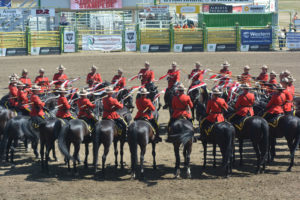RCMP turns 100
By Janet Kanters Times Editor


Janet Kanters Photo
On Feb. 1, 1920, the federal government merged the Royal North-West Mounted Police and the Dominion Police – a federal force established in 1868 to guard government buildings and to enforce federal statutes – forming the RCMP.
Today, the RCMP provides an array of services, from municipal policing, to national security intelligence gathering, to the legendary Musical Ride. The RCMP’s formal primary mandate remains the prevention of crime and the maintenance of peace and order. It also provides police services to eight of the 10 Canadian provinces, (excluding Quebec and Ontario), as well as to the three northern territories, and more than 180 municipalities and Indigenous communities.
In late 2019, the RCMP set up its first union – the National Police Federation – to represent RCMP members in such areas as pay, health benefits, insurance, equipment, etc. The union hopes to start salary bargaining by mid-March 2020. Mounties make less than officers in most municipal forces right across the country, with a starting annual salary of $53,144 for an RCMP officer.
History
On May 3, 1873, Prime Minister Sir John A. Macdonald introduced a bill to establish a police force in the North-West Territories. On May 23 the bill was passed and the North-West Mounted Police (NWMP) came into being. One hundred and fifty recruits were sent west to spend the winter at Fort Garry (what is now Winnipeg) and the following spring another 150 joined them.
Over the next 30 years, the force increased in manpower, and spread throughout what is now the three prairie provinces and into the territories. In 1903, the first mounted police north of the Arctic Circle was established at Fort McPherson and a detachment set up at Cape Fullerton on the western shore of Hudson Bay. By this time, the force was known as the Royal North-West Mounted Police (RNWMP).
Alberta and Saskatchewan were created out of the North-West Territories in 1905. By 1917, each had set up their own provincial police forces: Alberta Provincial Police was in service from 1917 to 1932, and Saskatchewan Provincial Police from 1917 to 1928.
Then on Feb. 1, 1920, the RCMP was formed, with its main activities the enforcement of narcotics laws, and security and intelligence work. Between 1931 and 1938, the size of the RCMP nearly doubled, from 1,350 to 2,350 men, as the force took over provincial policing in Alberta, Manitoba, New Brunswick, Nova Scotia and Prince Edward Island. In 1950, the RCMP assumed responsibility for additional provincial policing in Newfoundland and British Columbia.
RCMP in Strathmore and Gleichen
According to Mark Gaillard, RCMP Historian, the distribution state of the RNWMP dated Sept. 30, 1909 shows that both Strathmore and Gleichen were detachments of “E” Division, headquartered in Calgary. At that time there was one constable and two horses at Strathmore; and one staff sergeant, one constable and two special constables, along with four horses, at Gleichen.
“On February 28, 1917, the RNWMP was withdrawn from policing duties in Alberta. Policing was now the responsibility of the Alberta Provincial Police (APP),” said Gaillard. “The RNWMP had responsibility only for enforcement of federal statutes and policing in national parks.”
On April 1, 1932, the RCMP once again assumed responsibility for police operations and duties in Alberta. Most of the APP personnel and detachments were absorbed into the RCMP which expanded to almost 100 detachments and over 300 members.
Today, the Strathmore RCMP detachment is comprised of 14 municipal and nine rural officers, which are included in the total of 29 members in the detachment. The Gleichen RCMP detachment, meanwhile, boasts a total of 20 members.
